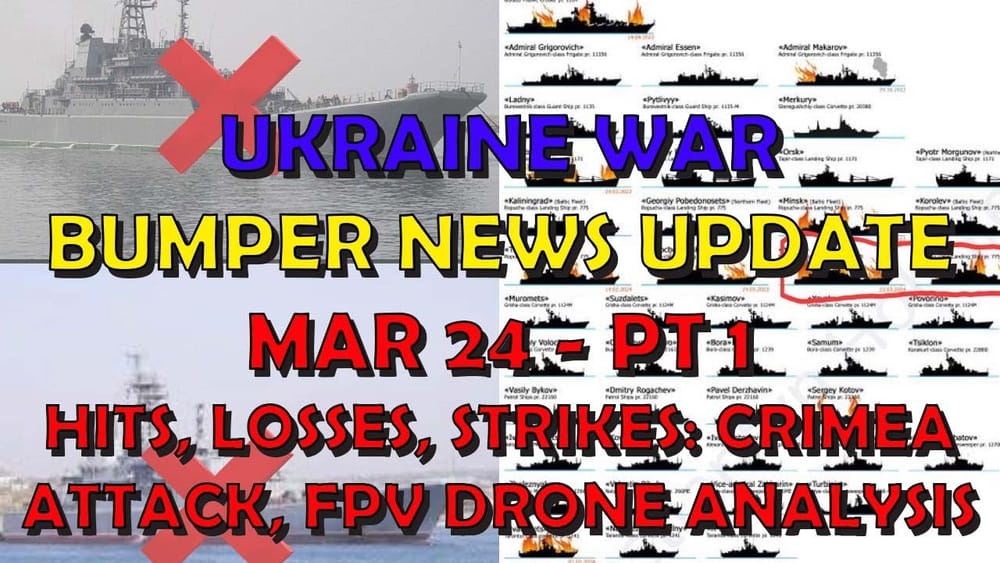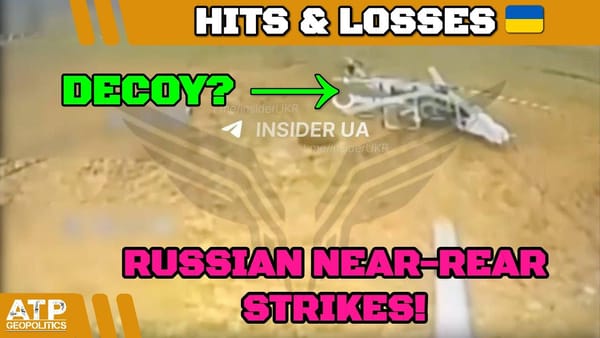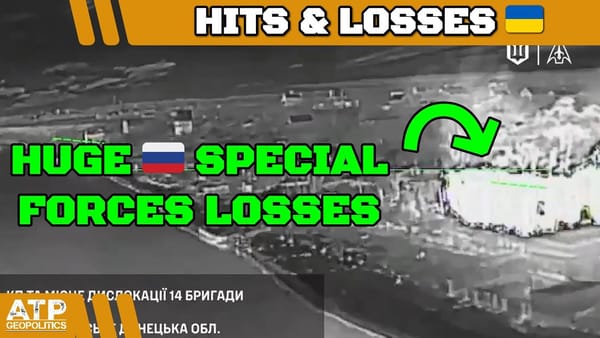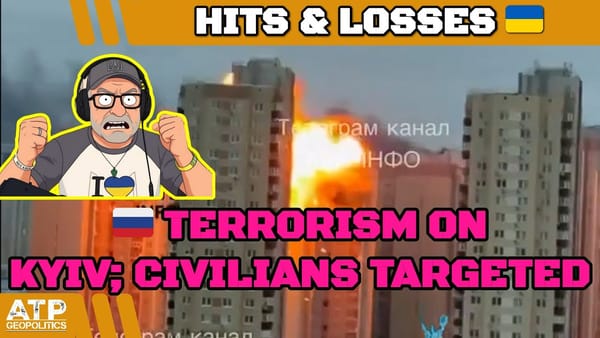Ukraine War Update NEWS: Pt 1 - Overnight & Other News, Terrorist Attack Analysis
Table of Contents 📖
"What would Poland do if they had 600 troops that were traveling on infantry fighting vehicles along the same amount of land that that cruise missile covered but that they weren't going they weren't going to attack Poland they were just driving through Poland on their infantry fighting vehicles to eventually attack the west of Ukraine what would the Polish do if you had armed soldiers traveling through Poland?"
Hello Team
🎦 00:00-00:29⏩
Jonathan welcomes viewers to a new Ukraine War News Update, expressing a sense of positivity and hopefulness that accompanies the arrival of spring. Despite the hopeful atmosphere, the news remains dominated by the ongoing conflict.
Return to top⤴️
🪦 DISCLAIMER FOR GENERAL STAFF LOSSES DATA
- These are real people with real lives and real families who love them. Don’t let the numbers sap your humanity.
- These numbers probably aren’t accurate but they’re the best we have and we don’t need them to be accurate to be indicative of patterns of activity.
- All losses are estimates. Losses cannot be counted with accuracy because of the conditions on the ground.
- Both sides would see it to be of their advantage to minimize their own losses maximize the other side’s losses.
- Neither side releases their losses but we have enough transparency from the Ukrainian side to have confidence in they are indicative.
- Personnel losses are hard to count. If a soldier gets injured, heals up, and returns to the front line only to get injured again, is that one loss or two? Also, how to deal with losses from PMC’s or soldiers fighting with RF from occupied territories?
- Equipment losses are hard to count. If an AA complex involves several parts and one part gets disabled, is that a loss, or a fraction of a loss? If a tank gets disabled, repaired, back into the fight, then disabled again, is that one lost tank or two?
- All recorded losses are vulnerable to multiple reporting. We have already seen numerous cases of multiple drones in the air reporting the same loss from different angles as multiple engagements.
- Losses are not always reported on the same day they occurred. It is frequent that drone losses are reported at least 24 hours after other terrestrial equipment losses. Certain losses may not be reported for days or weeks for military intelligence reasons.
Initial Assessment of the Situation
🎦 00:29-00:48⏩
Jonathan highlights Ukraine's successful strikes on Crimea, targeting naval assets and key infrastructure. In retaliation, Russia launched widespread missile and drone attacks across Ukraine, focusing on energy infrastructure.
Return to top⤴️
Analysis of Russian Losses
🎦 00:48-03:51⏩
- Jonathan analyses the Ukrainian General Staff's report on Russian losses, noting a significant number of personnel (990), tanks (24), armoured vehicles (28), and artillery systems (44) lost by the Russians.
- He observes that visual confirmation from social media supports the General Staff’s claims.
- He highlights the analysis of data from 'Andrew Perpetua', indicating a consistent five-to-one loss ratio in favour of Ukraine.
- Despite acknowledging the challenging situation on the front lines, Jonathan emphasises the heavy cost inflicted on Russian forces in terms of both personnel and equipment. He suggests that while Ukrainian troops might feel overwhelmed, the data confirms that Russia is suffering far greater casualties.
- Referencing a comment from viewer 'Viggo Holmsson', Jonathan discusses the loss of a Ukrainian NASAMS launcher northwest of Zaporizhia, speculating its potential use in offensive air defence operations.
Analysis of Ukrainian Losses
🎦 03:51-10:15⏩
- Jonathan reassures viewers that the loss of the NASAMS launcher is not as significant as it might seem, as it represents the cheapest and most replaceable component of the system.
- He provides an overview of Ukrainian equipment losses, which include a communications equipment boat, a self-propelled mortar, and damage to an M777 howitzer, in addition to the NASAMS launcher.
- Conversely, Russian losses, visually confirmed through sources like 'Andrew Perpetua,' include a Strela-10 air defence system, electronic warfare equipment, various artillery pieces, a significant number of tanks, infantry fighting vehicles, and logistics vehicles like trucks and ATVs.
- Jonathan emphasises the sheer scale of Russian equipment losses, questioning whether the loss of a single NASAMS launcher for Ukraine outweighs the destruction of numerous Russian assets.
- He reports on a captured US-supplied Bradley Infantry Fighting Vehicle, highlighting the 72nd confirmed loss and the 3rd confirmed capture of this model. Despite being older equipment, Jonathan underscores the effectiveness of Bradleys, noting their continued relevance and effectiveness in modern warfare.
Ukrainian Partisan Activities in Melitopol
🎦 10:15-10:58⏩
Jonathan reports on successful operations by Ukrainian partisans in occupied Melitopol. Working in coordination with Ukrainian intelligence, these resistance fighters destroyed Russian military equipment and inflicted casualties. The attack targeted a group of Russian soldiers and their equipment, resulting in the destruction of two Kamaz trucks and a UAZ Patriot vehicle.
Return to top⤴️
In-depth Analysis of Drone Warfare Data
🎦 10:58-31:42⏩
- Jonathan delves into an analysis of drone warfare data with a specific focus on First-Person View (FPV) drones. He draws upon data and insights from 'Dana,' a respected analyst he has collaborated with and interviewed in the past, referencing 'Touch' and 'Dima from Wild Hornet,' a Ukrainian drone manufacturer, as valuable sources of information.
- He acknowledges the difficult situation Ukrainian troops face on the front lines, especially in areas like Chasiv Yar, where they are losing ground. However, he emphasises that data suggests a different reality compared to the perceptions of some soldiers on the ground.
- Data analysis reveals a significant increase in Ukrainian FPV drone strikes, both in terms of overall numbers and their effectiveness against Russian personnel, vehicles, and positions. This trend indicates a concerted effort by Ukraine to leverage this technology to counter Russian advances.
- Jonathan dissects the data further, comparing month-on-month figures to demonstrate the rapid growth of Ukraine's FPV drone capabilities, especially in comparison to a decline in observed Russian FPV drone activity. He also examines the types of targets being prioritised by both sides.
- Addressing the apparent discrepancy between data analysis and reports from Ukrainian soldiers who feel overwhelmed by Russian drone activity, Jonathan explores several possibilities. He suggests these include:
- Incorrect Perception Versus Reality: Soldiers might perceive a greater Russian drone presence than what the data suggests, perhaps due to the psychological impact of drone warfare.
- Localised Drone Advantage: While Ukraine might have an overall advantage in FPV drone usage across the front line, Russia could still maintain superiority in specific sectors like Chasiv Yar, leading to localised Ukrainian losses.
- Data Selection Bias: It is possible that available data might not fully reflect the reality on the ground. Ukrainians might be more effective in documenting and sharing their drone operations compared to the Russians, leading to a potential overrepresentation of Ukrainian successes.
- Jonathan concludes this segment by cautioning against drawing conclusions solely based on FPV drone data. He reminds viewers that a holistic understanding of the conflict requires considering other factors such as conventional artillery, aviation, electronic warfare, and overall strategic objectives.
Russian Missile and Drone Attacks on Ukraine
🎦 31:42-36:19⏩
- Jonathan shifts focus to the overnight Russian missile and drone attacks across various regions of Ukraine. He reports on the scale of the attacks, noting the types of munitions used and their targets, contrasting them with the previous night’s larger-scale assault. He observes a lower number of missiles and drones employed by the Russians, speculating on potential production or logistical challenges. Despite a high interception rate by Ukrainian air defenses, some strikes were successful. He also highlights a concerning incident where a Russian cruise missile violated Polish airspace.
- He analyses the trajectory and behavior of these missiles and drones using various infographics and maps. This analysis reveals deliberate attempts to evade Ukrainian air defences, highlighting the complexities of aerial warfare.
- Jonathan provides a detailed account of the Russian cruise missile entering Polish airspace, remaining within its borders for a concerning 39 seconds before returning to Ukrainian airspace.
Ukrainian Missile Strike on Crimea
🎦 36:19-44:52⏩
- Shifting to a positive development for Ukraine, Jonathan reports on their successful retaliatory missile strikes against targets in Crimea, specifically mentioning cities like Sevastopol, Simferopol, and Chornomorsk. He notes significant damage inflicted on Russian military infrastructure and equipment.
- He highlights the successful targeting of the Russian Black Sea Fleet's Information and Computing Center in Sevastopol, disrupting their communication capabilities. Visuals of explosions and secondary detonations suggest strikes on ammunition depots or fuel storage facilities.
- Quoting Ukrainian Air Force Commander, 'Oleschuk,' Jonathan shares his satisfaction with the results of the operation.
- Further confirmed reports indicate successful strikes on Russian naval assets, including the large amphibious landing ships 'Yamal' and 'Asof.' Jonathan emphasises the significance of these losses, particularly in the context of any potential future Russian amphibious operations.
- He provides detailed accounts of the targets struck, citing information from Ukrainian and Russian sources, including Anton Gerashchenko and the Ukrainian General Staff.
- He wraps up this section by highlighting the strategic importance of the Ukrainian strikes, disrupting Russian logistics, command and control, and potentially impacting their ability to sustain prolonged offensive operations.
Wrap up
🎦 44:52-45:05⏩
Jonathan concludes the video, teasing an upcoming segment focusing on geopolitical analysis and updates on military equipment.
Return to top⤴️



